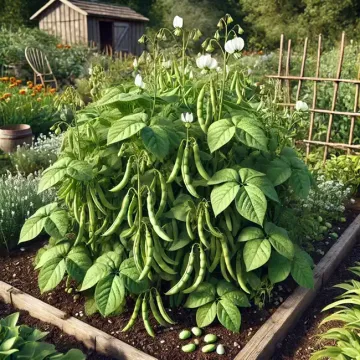Bush beans (Phaseolus vulgaris) are green beans that grow in a bushy, compact form, typically reaching about 1 to 2 feet in height. Unlike pole beans, which require a trellis or other support structure, bush beans can stand independently, making them an excellent option for small gardens, container gardening, or raised beds. Bush beans come in various varieties, including snap beans (green beans), wax beans (yellow beans), and even some purple-podded varieties.
Why Grow Bush Beans?
- Easy to Grow: Bush beans are relatively low-maintenance, making them an excellent choice for beginners.
- Fast Harvest: Most bush bean varieties mature quickly, with some ready for harvest in as little as 50 to 60 days after planting.
- Compact Size: Their small, bushy growth habit makes them perfect for gardens with limited space or for growing in containers.
- Continuous Harvest: You can enjoy fresh beans throughout the growing season with successive planting.
- Nitrogen Fixation: Like other legumes, bush beans help improve soil fertility by fixing nitrogen, which benefits other garden plants.
Planting Bush Beans
- When to Plant: Bush beans are warm-season crops and should be planted after the danger of frost has passed and the soil has warmed to at least 60°F (16°C). In most regions, this means planting in late spring.
- Soil Requirements: Bush beans thrive in well-drained, loamy soil with a pH of 6.0 to 7.5. Adding organic matter, such as compost, to the soil before planting can help improve soil structure and fertility.
- Planting: Plant bush bean seeds about an inch deep and 1 to 2 inches apart. You can plant nine plants per square foot using the square-foot gardening method.
- Sunlight: Beans require full sun, so choose a location in the garden that receives at least 6 to 8 hours of direct sunlight daily.
Caring for Bush Beans
- Watering: Keep the soil consistently moist but not waterlogged. Beans need about 1 inch of water per week, especially during flowering and pod formation. Avoid overhead watering to prevent disease, and water at the base of the plants instead.
- Mulching: Applying a layer of mulch around the plants helps retain soil moisture, suppress weeds, and regulate soil temperature.
- Fertilization: Bush beans typically do not require heavy fertilization, especially if the soil is rich in organic matter. However, a light application of balanced fertilizer (e.g., 10-10-10) at planting time can give them a good start.
- Weeding: Regularly remove weeds that compete with bush beans for nutrients and water. Be careful not to disturb the shallow roots of the plants when weeding.
Pests and Diseases
Bush beans are generally resilient but can be susceptible to pests and diseases. Common pests include aphids, bean beetles, and cutworms. Handpicking pests and using organic insecticidal soap can help manage infestations.
Diseases like powdery mildew, rust, and bacterial blight can also affect bush beans. To reduce disease risk, practice crop rotation.
Harvesting Bush Beans
Depending on the variety, Bush beans are usualy ready for harvest about two months after planting. Beans should be harvested when the pods are crisp and fully developed, but before the seeds inside bulge. To harvest, snap the pods off the plant by hand. Check your plants every few days during the season's peak or you may end up with beans that are large and tough. Also, harvesting beans when they are small encourages more beas to grow.
Storing and Using Bush Beans
Fresh bush beans can be stored in the refrigerator for up to a week. If you have a bumper crop, bush beans can be blanched and frozen for more extended storage. They can also be canned or pickled for later use.
Popular Varieties of Bush Beans
- 'Blue Lake': A popular variety known for its tender, stringless pods and excellent flavor.
- 'Provider': An early-maturing variety that is disease-resistant and produces high yields.
- 'Contender': A heat-tolerant variety that is perfect for warmer climates.
- 'Royal Burgundy': A striking purple-podded variety that adds visual interest to the garden and turns green when cooked.
Whether growing them in a traditional garden bed, a raised bed, or a container, bush beans are a fantastic choice for gardeners of all experience levels.

